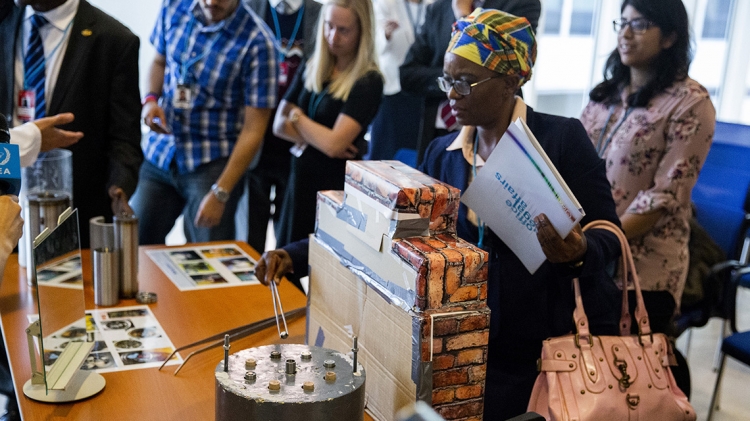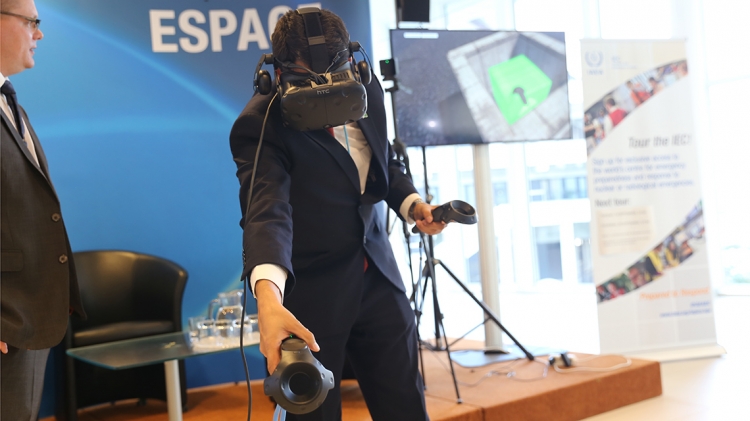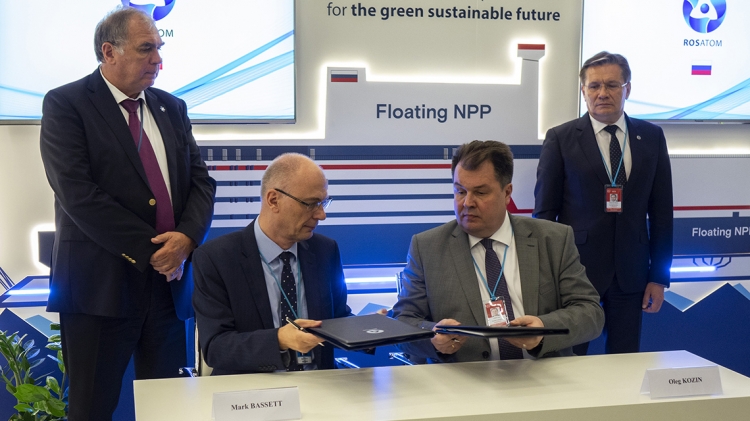
Delegates participate at the 'hands-on demonstration of handling disused sealed radioactive sources' side event that took place during the General Conference. (Photo: F. Nassif/IAEA)
There was a side event on the presentation of the IAEA’s energy planning tools used by approximately 150 Member States (regardless of their interest in nuclear power). Using these tools, energy planners and policy analysts can plan and create optimal supply mixes, ultimately proposing the most effective approach to meeting future energy needs.
During the International Nuclear Safety Group (INSAG) Forum 2018, the focus was on the on the implementation of safety standards. The panellists highlighted the importance of implementation to ensure a high level of nuclear and radiological safety worldwide. The IAEA explained what trends had been identified by peer review and advisory services and participants asked about information sharing, timelines and quality of translations of standards.
Member States side events:
At the event Physical and Cyber Security of Nuclear Facilities organised by the United Kingdom, speakers shared the county’s experience and the collaborative approach among policy makers, regulators and industry for the development of best practice solutions for physical and cyber nuclear security.
Canada’s Small Modular Reactor (SMR) Roadmap: Co-Creating the Path Forward, featured presentations by the Canadian government, regulatory, laboratory and industry representatives on Canada’s work on SMRs. The discussion covered Canada’s path forward and key areas for international collaboration.
The event on the Review of Sogin’s Plans for Dismantling of Garigliano and Trino Reactor Pressure Vessels: Results organised by Italy, highlighted work on facilities that were subject to the IAEA Integrated Review Service for Radioactive Waste and Spent Fuel Management, Decommissioning and Remediation (ARTEMIS).
The event on Brazil’s Nuclear Programme, included a presentation of the different areas of the programme, and highlighted activities and issues on energy production, technology application and defence, including aspects of the development of a nuclear propulsion submarine.
The event Accelerated Progress in Fukushima Daiichi (1F) Decontamination and Decommissioning, organised by Japan, provided an opportunity for a dialogue between representatives from Japan and the audience to reveal the progress that has been achieved at Fukushima Daiichi in the past seven years since the accident.
The Nuclear digital transformation event, organised by France, provided examples from the French nuclear industry on numerous initiatives by large companies, small and medium-sized enterprises and start-ups that are under way in various fields. This event provided an opportunity to meet pioneers of the digital transformation and to share practical cases.
Other activities:
Country Programme Framework (CPF)
A CPF is the frame of reference for the medium-term planning of technical cooperation between a Member State and the IAEA and identifies priority areas where the transfer of nuclear technology and technical cooperation resources will be directed to support national development goals.
Abdykalyk Rustamov, Director of the Kyrgyz State Agency on Environment Protection and Forestry and Dazhu Yang, IAEA Deputy Director General and Head of the Department of Technical Cooperation, signed Kyrgyzstan’s Country Programme Framework for the period 2018-2023.
Ambassador James Alex Msekela, Permanent Representative of Tanzania to the IAEA, and Dazhu Yang, IAEA Deputy Director General and Head of the Department of Technical Cooperation, signed Tanzania’s Country Programme Framework (CPF) for the period of 2018–2022.
The IAEA and Russia signed a contract for the transport of low enriched uranium (LEU) and equipment through Russian territory to and from IAEA LEU Bank in Kazakhstan. Mark Bassett, IAEA LEU Bank Executive, and Oleg Kozin, Deputy Director General, TENEX, (the authorized organization to conclude the Transport Contract with the IAEA) are pictured here signing the contract.










